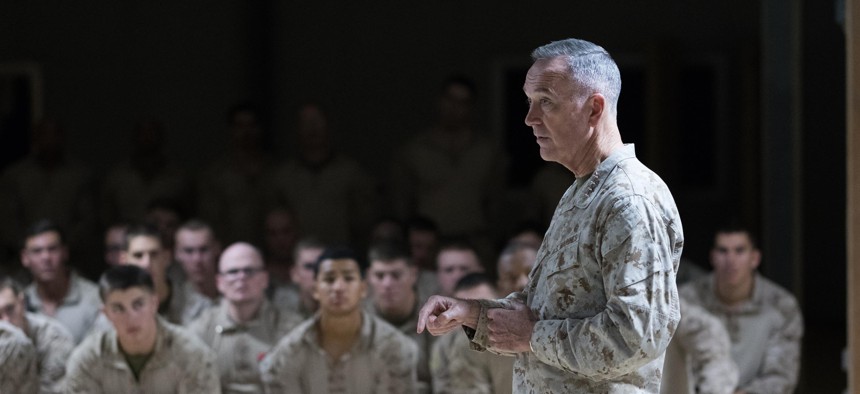
Joint Chiefs chairman Gen. Joseph Dunford addresses troops in Taqaddum, Iraq, in November 2016. Defense Department / Myles Cullen
Expect a Lot of Modernization Spending in the Next Few Years: Gen. Dunford
The 2018-21 budgets will be crucial in setting up the U.S. military for the future, says the Joint Chiefs chairman.
The Joint Chiefs have been particularly focused on military readiness of late, so with the Pentagon’s 2018 budget request set to come out next week, I asked Chairman Gen. Joseph Dunford about it as we flew home from a NATO meeting in Brussels.
“What we began last year, and what I think you’ll see continue next year, is a recognition that we’ve got to start to look to the future as well as meeting our current operational requirements, Dunford said. “I think it’s fair to say that when we went through a period of unstable budgets, particularly starting in 2010, we delayed a lot of modernization that now has to be addressed.”
Areas that particularly need investment, he said, include electronic warfare, cyber, space, modernizing the nuclear triad, and maritime requirements.
Dunford alluded to Defense Secretary Jim Mattis’ three-step approach to repairing readiness: first, fill equipment and training holes, then increase the capacity of the military, and finally, grow its lethality.
“Readiness is not only getting the equipment that you have ready, not only providing training to the troops, getting the right number of people there, but it’s also recapitalizing and modernizing,” the chairman said. “Now you’re not buying yesterday’s vehicle, yesterday’s aircraft.”
Filling equipment gaps does not necessarily mean refurbishing battle-worn weapons. For example, if a fighter jet reaches the end of its life or is destroyed in battle, expect the Pentagon to buy a newer, more modern plane.
“I think in ’18, we’ll start to get a little bit closer to that, and really, as we go into ’19, ’20 and ’21, in my judgment, that’s really when we need to make sure that we’re attentive to our modernization requirements because not only then are we talking about readiness, we’re talking about modern capabilities that preserve a competitive advantage for those key areas,” Dunford said.
This story was originally published as part of the May 18 Global Business Brief.
